
Trafikle ilgili anahtar kelimelere genel bakış. Burada henüz bilmediğiniz anahtar kelimeleri ve tanımları kolayca arayabilirsiniz.
More subjects
The Aesculapian snake /ˌɛskjəˈleɪpiən/ (now Zamenis longissimus, previously Elaphe longissima), is a species of nonvenomous snake native to Europe, a member of the Colubrinae subfamily of the family Colubridae. Growing up to 2 metres (6.6 ft) in length, it is among the largest European snakes, similar in size to the four-lined snake (Elaphe quatuorlineata) and the Montpellier snake (Malpolon monspessulanus). The Aesculapian snake has been of cultural and historical significance for its role in ancient Greek, Roman and Illyrian mythology and derived symbolism. (Source: Wikipedia.org, CC BY-SA)
Agama (from Sranan Tongo meaning 'lizard') is a genus of small-to-moderate-sized, long-tailed, insectivorous Old World lizards. The genus Agama includes at least 37 species in Africa, especially sub-Saharan Africa, where most regions are home to at least one species. Eurasian agamids are largely assigned to genus Laudakia. The various species differ in size, ranging from about 12 to 30 centimetres (5 to 12 in) in length, when fully grown. Their colour also differs between species, between genders, and according to mood; for example, a dominant male in display mode is far brighter than when it has been caught, beaten by another male, or otherwise alarmed. Females tend to be less colourful than the males of the species. (Source: Wikipedia.org, CC BY-SA)
The Aldabra giant tortoise (Aldabrachelys gigantea) is a species of tortoise in the family Testudinidae. The species is endemic to the islands of the Aldabra Atoll in the Seychelles. It is one of the largest tortoises in the world. Historically, giant tortoises were found on many of the western Indian Ocean islands, as well as Madagascar, and the fossil record indicates giant tortoises once occurred on every continent and many islands with the exception of Australia and Antarctica. Many of the Indian Ocean species were thought to be driven to extinction by over-exploitation by European sailors, and they were all seemingly extinct by 1840 with the exception of the Aldabran giant tortoise on the island atoll of Aldabra. Although some remnant individuals of A. g. hololissa and A. g. arnoldi may remain in captivity, in recent times, these have all been reduced as subspecies of A. gigantea. (Source: Wikipedia.org, CC BY-SA)
An alligator is a large reptile in the Crocodilia order in the genus Alligator of the family Alligatoridae. The two extant species are the American alligator (A. mississippiensis) and the Chinese alligator (A. sinensis). Additionally, several extinct species of alligator are known from fossil remains. Alligators first appeared during the Oligocene epoch about 37 million years ago. The name 'alligator' is probably an anglicized form of el lagarto, the Spanish term for 'the lizard', which early Spanish explorers and settlers in Florida called the alligator. Later English spellings of the name included allagarta and alagarto. (Source: Wikipedia.org, CC BY-SA)
Anacondas or water boas are a group of large snakes of the genus Eunectes. They are found in tropical South America. Four species are currently recognized. Although the name applies to a group of snakes, it is often used to refer only to one species, in particular, the common or green anaconda (Eunectes murinus), which is the largest snake in the world by weight, and the second longest after the reticulated python. (Source: Wikipedia.org, CC BY-SA)
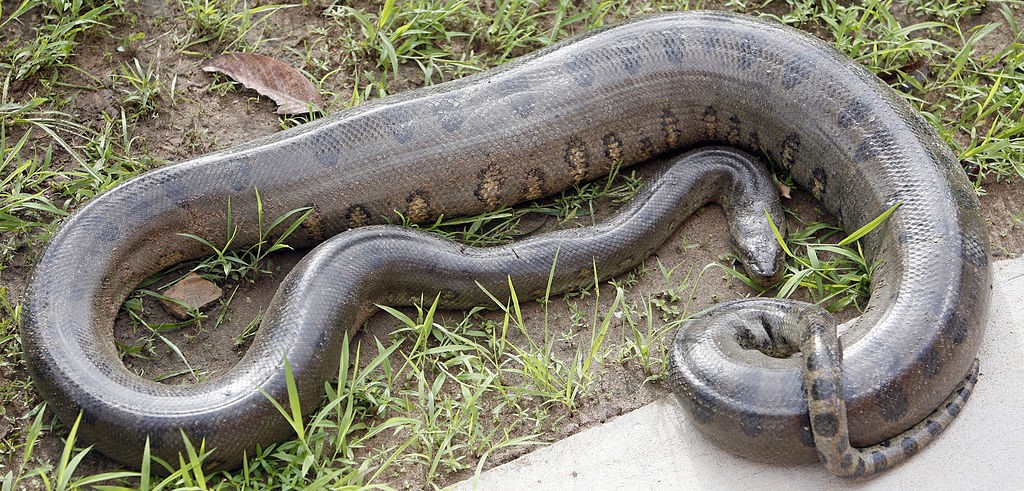 © Wikimedia.org/Wagnermeier, CC BY-SA
© Wikimedia.org/Wagnermeier, CC BY-SA
Dactyloidae are a family of lizards commonly known as anoles (US: /əˈnoʊ.liz/ ) and native to warmer parts of the Americas, ranging from southeastern United States to Paraguay. Instead of treating it as a family, some authorities prefer to treat it as a subfamily, Dactyloidae, of the family Iguanidae. In the past they were included in the family Polychrotidae together with Polychrus (bush anoles), but the latter genus is not closely related to the true anoles. Anoles are small to fairly large lizards, typically green or brownish, but their color varies depending on species and many can also change it. In most species at least the male has a dewlap, an often brightly colored flap of skin that extends from the throat/neck and is used in displays. Anoles share several characteristics with geckos, including details of the foot structure (for climbing) and the ability to voluntarily break off the tail (to escape predators), but they are only very distantly related, anoles being part of Iguania. (Source: Wikipedia.org, CC BY-SA)
Crotalus cerberus is a venomous pit viper species found in the southwestern United States. It is known as the Arizona black rattlesnake, black rattlesnake, and several other common names. The color pattern consists of a dark grayish, brownish black, reddish brown, or blackish ground color, overlaid with a dorsal pattern of blotches that are rectangular anteriorly, becoming subhexagonal posteriorly, eventually becoming crossbands just before the tail. However, specimens also may be a uniform dark color without any clear dorsal pattern, or the dorsal blotches may be even darker and bordered with white, cream, or yellow transverse rows of scales, or the color pattern may be quite pale with a significant amount of yellow mixed in. A postocular stripe is evident in lightly colored specimens, but not so much in darker ones. (Source: Wikipedia.org, CC BY-SA)
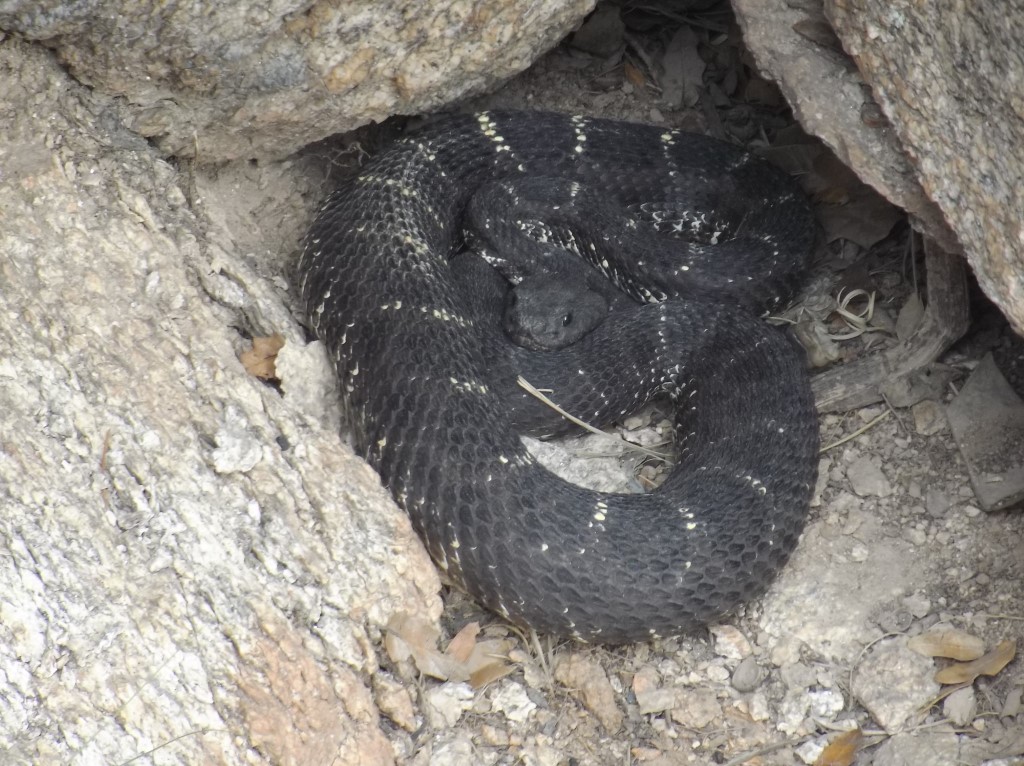 © Wikimedia.org/TheLoneStarState, CC BY-SA
© Wikimedia.org/TheLoneStarState, CC BY-SA
The armadillo girdled lizard (Ouroborus cataphractus), also commonly known as the armadillo lizard, the armadillo spiny-tailed lizard, and the golden-armadillo lizard, is a species of lizard in the family Cordylidae. The species is endemic to desert areas along the western coast of South Africa. In 2011, it was moved to its own genus based on molecular phylogeny, but formerly it was included in the genus Cordylus. The armadillo girdled lizard can be a light brown to dark brown in coloration. The underbelly is yellow with a blackish pattern, especially under the chin. Its size can range from 7.5 to 9 cm (3.0 to 3.5 in) in snout-vent length (SVL). It may grow to a maximum size of 8 in (20 cm) SVL. (Source: Wikipedia.org, CC BY-SA)
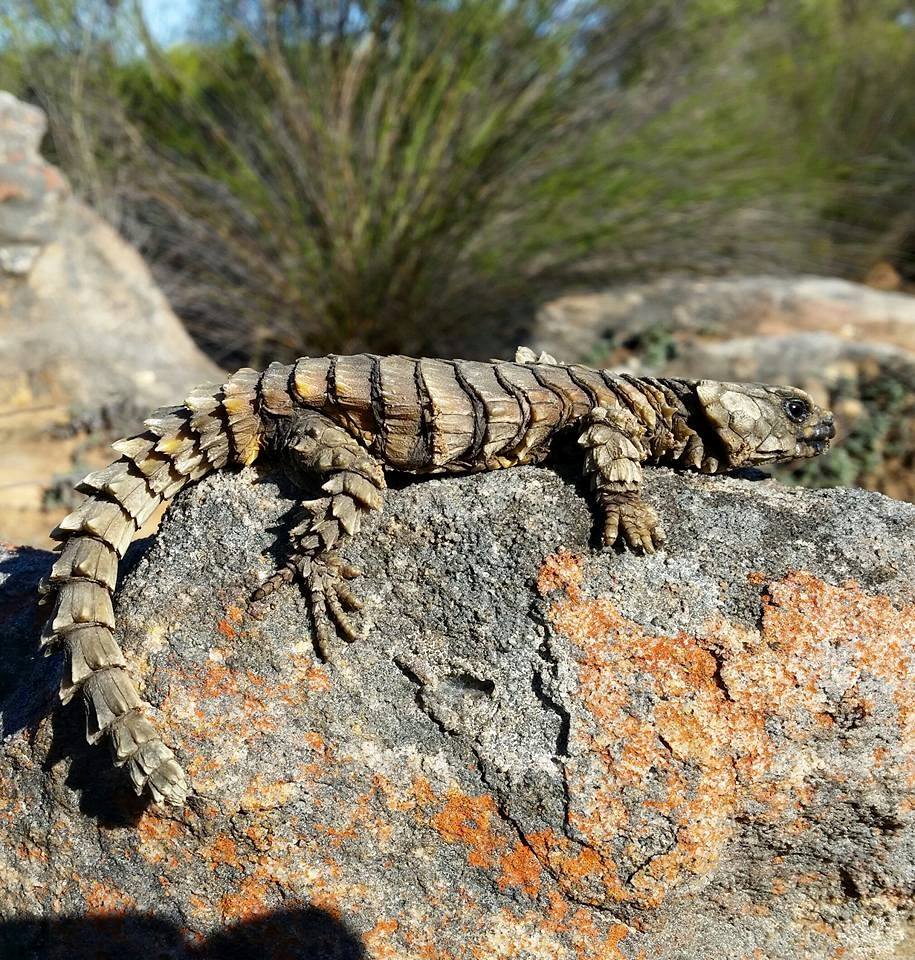 © Wikimedia.org/Handré Basson, CC BY-SA
© Wikimedia.org/Handré Basson, CC BY-SA
Crotalus unicolor is a venomous pitviper species found only on the Caribbean island of Aruba, off the coast of Venezuela. It is sometimes still classified as a subspecies of Crotalus durissus. Moderately sized, this species attains an adult length of approximately 90 cm, and weighs about one kilogram. It is light brown, tan, or almost pink in color, reflecting the soil color of its native habitat, with darker brown diamond-shaped markings, but colors may vary from white to apricot, or brown to slate. The markings are sometimes nearly invisible, or only visible in a narrow stripe down the middle of the back. (Source: Wikipedia.org, CC BY-SA)
Ahaetulla prasina is a species of snake in the family Colubridae native to southern Asia. Its common names include Asian vine snake, Boie's whip snake, Gunther's whip snake, Oriental whip snake (Thai: งูเขียวหัวจิ้งจก) . The body form is extremely slender with a long, pointed, projecting snout which is rather more than twice as long as the eye. Adult colouration varies from light brown to dull yellow-green and often a startling fluorescent green. Adults may attain 1.8 m (6 feet) in total length, with a tail 0.6 m (2 feet) long. (Source: Wikipedia.org, CC BY-SA)
Asp is the modern anglicisation of the word 'aspis', which in antiquity referred to any one of several venomous snake species found in the Nile region. The specific epithet, aspis, is a Greek word that means 'viper'. It is believed that aspis referred to what is now known as the Egyptian cobra. (Source: Wikipedia.org, CC BY-SA)
Pantherophis bairdi is a species of harmless snake in the family Colubridae. The species is native to the southwestern United States and adjacent northeastern Mexico. No subspecies are recognized as being valid. Adults of P. bairdi may reach 64 to 140 cm (25 to 55 in) in total length (including tail). The dorsal color pattern consists of an orange-yellow to bright yellow, or a darker salmon ground color, overlaid with four stripes that run from the neck to the tail. The belly is generally gray to yellow, darkening near the tail.[citation needed] (Source: Wikipedia.org, CC BY-SA)
The ball python (Python regius), also called the royal python, is a python species native to West and Central Africa, where it lives in grasslands, shrublands and open forests. This nonvenomous constrictor is the smallest of the African pythons, growing to a maximum length of 182 cm (72 in). The name 'ball python' refers to its tendency to curl into a ball when stressed or frightened. The ball python is black, or albino and dark brown with light brown blotches on the back and sides. Its white or cream belly is scattered with black markings. It is a stocky snake with a relatively small head and smooth scales. It reaches a maximum adult length of 182 cm (6 ft 0 in). Males typically measure eight to ten subcaudal scales, and females typically measure two to four subcaudal scales. Females reach an average snout-to-vent length of 116.2 cm (45+3⁄4 in), a 44.3 mm (1+3⁄4 in) long jaw, an 8.7 cm (3+7⁄16 in) long tail and a maximum weight of 1.635 kg (3 lb 9.7 oz). Males are smaller with an average snout-to-vent length of 111.3 cm (43+13⁄16 in), a 43.6 mm (1+23⁄32 in) long jaw, an 8.6 cm (3+3⁄8 in) long tail and a maximum weight of 1.561 kg (3 lb 7.1 oz). Both sexes have pelvic spurs on both sides of the vent. During copulation, males use these spurs for gripping females. Males tend to have larger spurs, and sex is best determined by manual eversion of the male hemipenes or inserting a probe into the cloaca to check the presence of an inverted hemipenis. (Source: Wikipedia.org, CC BY-SA)
The banded water snake or southern water snake (Nerodia fasciata) is a species of mostly aquatic, nonvenomous, colubrid snakes endemic to the Midwest and Southeastern United States. Adults of the banded water snake measure from 61.0 to 107 cm (24.0 to 42.1 in) in total length, with a record size (in the Florida subspecies) of 158.8 cm (62.5 in) in total length. In one study, the average body mass of adult banded water snakes was 464.3 g (16.38 oz). It is typically gray, greenish-gray, or brown in color, with dark crossbanding. Many specimens are so dark in color that their patterning is barely discernible. The ventrum (belly) is typically an off-white to white. They have flat heads, and are fairly heavy-bodied. Banded water snakes may also be identified by a dark stripe which extends from the eye to the angle of the jaw. If irritated, they release a foul-smelling musk to deter predators.[citation needed] This species also exhibits sexual dimorphism in which the female is generally longer and heavier than the male. Their appearance leads them to be frequently mistaken for other snakes with which they share a habitat, including the venomous cottonmouth. (Source: Wikipedia.org, CC BY-SA)
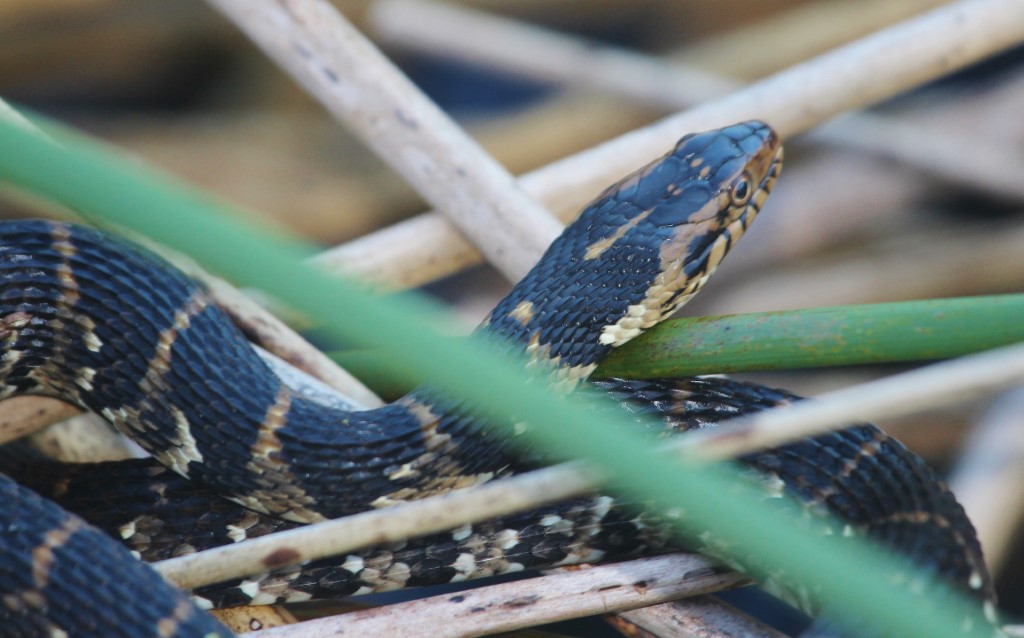 © Wikimedia.org/Sandhillcrane, CC BY-SA
© Wikimedia.org/Sandhillcrane, CC BY-SA
Basiliscus is a genus of large corytophanid lizards, commonly known as basilisks, which are endemic to southern Mexico, Central America, and northern South America. The genus contains four species, which are commonly known as the Jesus Christ lizard, or simply the Jesus lizard, due to their ability to run across water for significant distances before sinking due to the large surface area of their feet. Basilisks on average measure 70 to 75 cm (28 to 30 in) in total length (including tail). Their growth is perpetual, fast when they are young and nonlinear for mature basilisks.[citation needed] Their long crest-like sails, reinforced in three distinct points (head, back, and tail),[citation needed] confer the impression of creatures such as Dimetrodon and Edaphosaurus. Their skin is shed in pieces.[citation needed] (Source: Wikipedia.org, CC BY-SA)
Pogona is a genus of reptiles containing six lizard species which are often known by the common name bearded dragons. The name 'bearded dragon' refers to the underside of the throat (or 'beard') of the lizard, which can turn black and gain weight for a number of reasons, most often as a result of stress, or if they feel threatened. They are a semi-arboreal species, spending significant amounts of time on branches, in bushes, and near human habitation. Pogona species bask on rocks and exposed branches in the mornings and afternoons. Their diet consists primarily of insects, vegetation, and occasionally small rodents. They are found throughout much of Australia and inhabit a wide range of environments, such as deserts, shrublands and Eucalyptus woodlands. Adult bearded dragons are very territorial. As they grow, they establish territories in which displays of aggression and appeasement form a normal part of their social interactions. A dominant male will adopt a dominant stance and sometimes ready himself for a fight to attack a male aggressor to defend territory, food sources, or in competition for a female. Any male approaching without displaying submissive behavior will be seen as a challenge for territory. Aggressive males have even been known to attack females who do not display submissive gestures in return. (Source: Wikipedia.org, CC BY-SA)
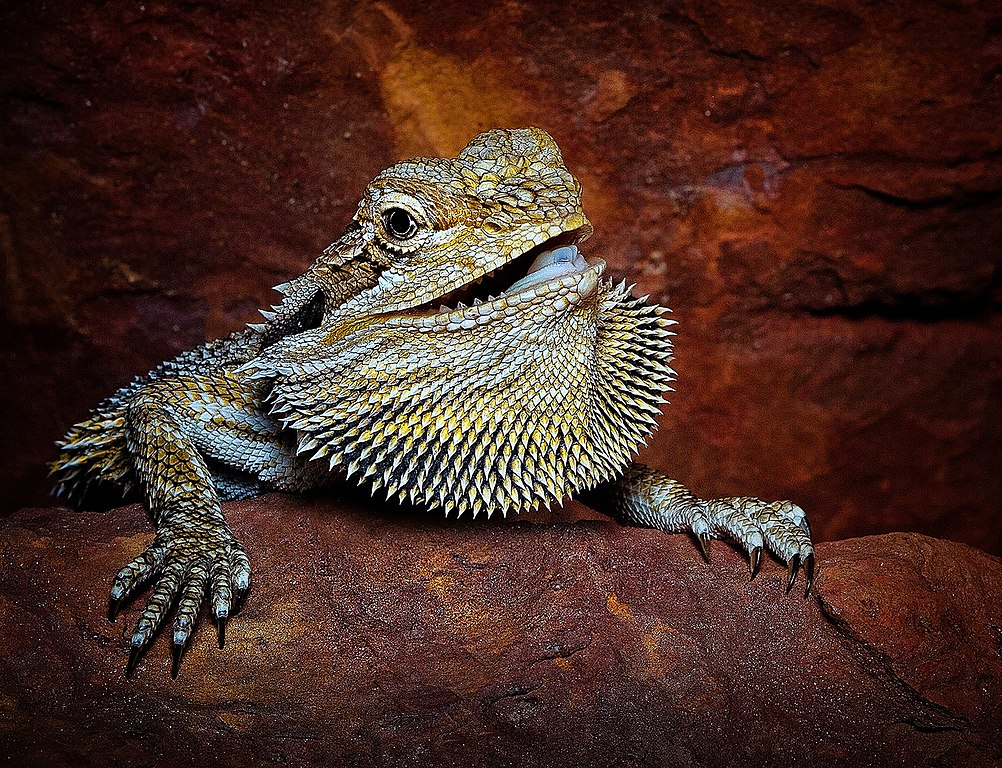 © Wikimedia.org/Toni Segers, CC BY-SA
© Wikimedia.org/Toni Segers, CC BY-SA
The beauty rat snake (Orthriophis taeniura, once of the Elaphe complex), also called the beauty ratsnake, the beauty snake, or the cave racer, is a species of snake in the family Colubridae. The species is native to the eastern and southeastern regions of Asia. It is a long, thin, semi-arboreal species of snake with several recognized subspecies.[citation needed] This constrictor feeds on rodents, and though it is favored in some locations as a natural pest control or pet, it is also considered an invasive species in other locations. Living about 15–25 years, the average length of the beauty rat snake (including the tail) is about 4–6 feet (1.2–1.8 m). (Source: Wikipedia.org, CC BY-SA)
The black mamba (Dendroaspis polylepis) is a species of highly venomous snake belonging to the family Elapidae. It is native to parts of sub-Saharan Africa. First formally described by Albert Günther in 1864, it is the second-longest venomous snake after the king cobra; mature specimens generally exceed 2 m (6 ft 7 in) and commonly grow to 3 m (9 ft 10 in). Specimens of 4.3 to 4.5 m (14 ft 1 in to 14 ft 9 in) have been reported. Its skin colour varies from grey to dark brown. Juvenile black mambas tend to be paler than adults and darken with age. The species is both terrestrial (ground-living) and arboreal (tree-living); it inhabits savannah, woodland, rocky slopes and in some regions, dense forest. It is diurnal and is known to prey on birds and small mammals. Over suitable surfaces, it can move at speeds up to 16 km/h (10 mph) for short distances. Adult black mambas have few natural predators. (Source: Wikipedia.org, CC BY-SA)
Pantherophis obsoletus, also known commonly as the western rat snake, black rat snake, pilot black snake, or simply black snake, is a nonvenomous species of snake in the family Colubridae. The species is native to central North America. There are no subspecies that are recognized as being valid. Its color variations include the Texas rat snake. Along with other snakes of the eastern United States, like the eastern indigo snake (Drymarchon couperi) and the eastern racer (Coluber constrictor), it is called “black snake”. Adults of P. obsoletus can become quite large, with a reported typical total length (including tail) of 106.5–183 cm (3 ft 6 in – 6 ft 0 in). It is the largest snake found in Canada. The record total length is 256.5 cm (8 ft 5 in), making it (officially) the longest snake in North America. Unofficially, indigo snakes (genus Drymarchon) are known to exceed it, and one wild-caught pine snake (Pituophis melanoleucus), with a portion of its tail missing, measured 111 inches (2.8 m).[citation needed] The body mass of P. obsoletus can range up to 0.5 to 2.2 kg (1.1 to 4.9 lb) in adults, although most adults are on the smaller end of this scale, per herpetology research sites, with weights most commonly between 0.77 and 1 kg (1.7 and 2.2 lb). (Source: Wikipedia.org, CC BY-SA)
The black-headed python (Aspidites melanocephalus) is a species of snake in the Pythonidae (the python family). The species is endemic to Australia. No subspecies are currently recognized. Adults of A. melanocephalus typically grow to 1.5–2 m (4.9–6.6 ft) in total length (including tail), but can grow to a maximum of 3.5 m (11 ft). The body is muscular with a flattened profile, while the tail tapers to a thin point. The top of the head is covered by large, symmetrical scales. The dorsal scales, which are smooth and glossy, number 50-65 rows at midbody, while 315-355 ventral scales occur. The tail has 60-75 mainly single subcaudal scales and the anal scale is single. The posterior subcaudals tend to be divided, often irregularly. The color pattern consists of shades of black, dark grey, brown, gold, and cream arranged in a banded or brindled pattern. The belly is light-colored, flecked with darker spots. The head is shiny black that also extends down the neck and throat for several inches. (Source: Wikipedia.org, CC BY-SA)
The Scolecophidia, commonly known as blind snakes or thread snakes, are an infraorder of snakes. They range in length from 10 to 100 centimetres (4 to 40 inches). All are fossorial (adapted for burrowing). Five families and 39 genera are recognized. The Scolecophidia infraorder is most likely paraphyletic. The common name of Scolecophidia, blind snakes, is based on their shared characteristic of reduced eyes that are located under their head scales. These head scales are found in all snakes and are referred to as spectacles, but within this infraorder, they are opaque, resulting in decreased visual capabilities. Reduced eyes of the Scolecophidia have been attributed to evolutionary origins of snakes, which are hypothesized to have arisen from fossorial ancestors, causing a loss of genes related to eyesight that later evolved again in higher snakes to be similar to other vertebrates due to convergent evolution. Newer research shows that seven of the 12 genes associated with bright-light vision in most snakes and lizards are not present in this infraorder, and the common ancestor of all snakes had better eyesight. Other shared characteristics include an absent left oviduct in four of the five families, aside from the Anomalepididae, which have a well developed yet reduced left oviduct. Aside from this, these snakes range in length from 10 to 100 cm (3.9 to 39.4 in). Their typical body shapes include slender, cylindrical bodies and small, narrow heads. All these families either lack or have a vestigial left lung and lack cranial infrared receptors. (Source: Wikipedia.org, CC BY-SA)
The Sumatran short-tailed python (Python curtus) is a species of the family Pythonidae, a nonvenomous snake native to Sumatra. The Sumatran short-tailed python has narrow subocular scales between the bottom of the eye and the top of the labial scales. The parietal scales do not join each other. P. curtus and P. breitensteini can be distinguished by the frontal and parietal scales on the tops of their heads. In both P. brongersmai and P. breitensteini, the parietal scales join. Adults grow to 1.5–1.8 m (4.9–5.9 ft) in length and are heavily built. The tail is extremely short relative to the overall length. The color pattern consists of a beige, tan, or grayish-brown ground color overlaid with blotches that are brick- to blood-red in color. (Source: Wikipedia.org, CC BY-SA)
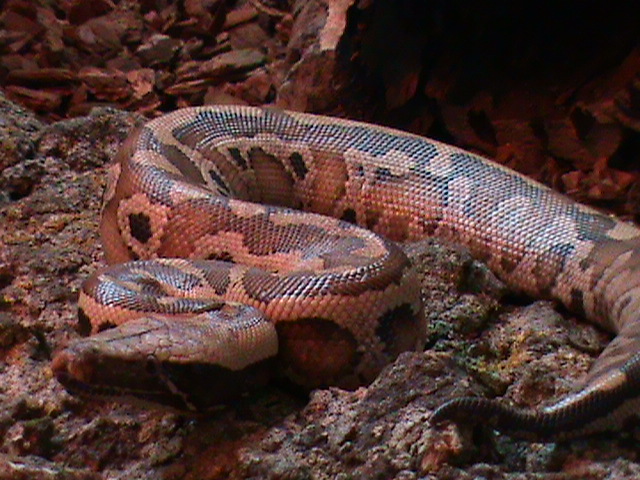 © Wikimedia.org/Lucas829, CC BY-SA
© Wikimedia.org/Lucas829, CC BY-SA
The western fence lizard (Sceloporus occidentalis) is a common lizard of Arizona, New Mexico, California, Idaho, Nevada, Oregon, Utah, Washington, Northern Mexico, and the surrounding area. As the ventral abdomen of an adult is characteristically blue, it is also known as the blue-belly. Western fence lizards measure 5.7–8.9 cm (snout-vent length) and a total length of about 21 cm. They are brown to black in color (the brown may be sandy or greenish) and have black stripes on their backs, but their most distinguishing characteristic is their bright blue bellies. The ventral sides of the limbs are yellow. male blue belly lizards also have blue patches on their throats. This bright coloration is faint or absent in both females and juveniles. In some populations the males also display iridescent, bright turquoise blue spots on the dorsal surface. The scales of S. occidentalis are sharply keeled, and between the interparietal and rear of thighs, there are 35–57 scales. (Source: Wikipedia.org, CC BY-SA)
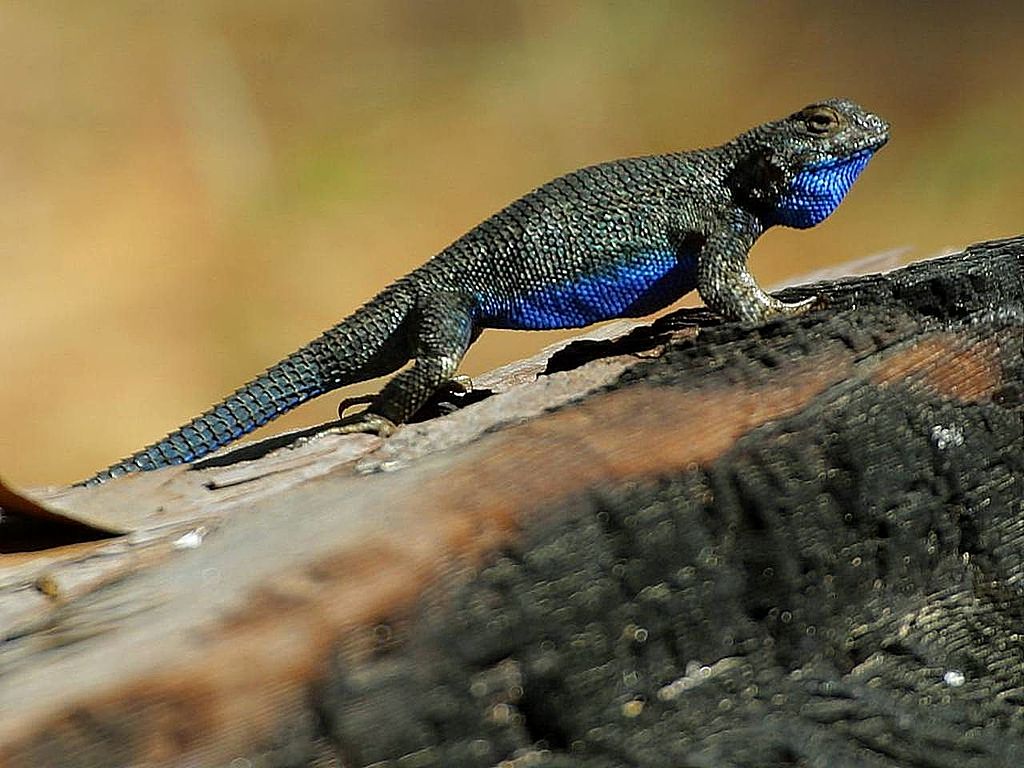 © Wikimedia.org/Jon Sullivan, CC0
© Wikimedia.org/Jon Sullivan, CC0
The blue iguana (Cyclura lewisi), also known as the Grand Cayman ground iguana, Grand Cayman blue iguana or Cayman Island rock iguana, is an endangered species of lizard which is endemic to the island of Grand Cayman. It was previously considered to be a subspecies of the Cuban iguana, Cyclura nubila, but in a 2004 article Frederic J. Burton reclassified it as a separate species because according to him the genetic differences discovered four years earlier between the different C. nubila populations warranted this interpretation. The blue iguana is one of the longest-living species of lizard (possibly up to 69 years). The preferred habitat for the blue iguana is rocky, sunlit, open areas in dry forests or near the shore, as the females must dig holes in the sand to lay eggs in June and July. A possible second clutch is laid in September. The blue iguana's herbivorous diet includes plants, fruits, and flowers. Its color is tan to gray with a bluish cast that is more pronounced during the breeding season and more so in males. It is large and heavy-bodied with a dorsal crest of short spines running from the base of the neck to the end of the tail. (Source: Wikipedia.org, CC BY-SA)
The Boidae, commonly known as boas or boids, are a family of nonvenomous snakes primarily found in the Americas, as well as Africa, Europe, Asia, and some Pacific Islands. Boas include some of the world's largest snakes, with the green anaconda of South America being the heaviest and second-longest snake known; in general, adults are medium to large in size, with females usually larger than the males. Five subfamilies, comprising 12 genera and 49 species, are currently recognized. Like the pythons, boas have elongated supratemporal bones. The quadrate bones are also elongated, but not as much, while both are capable of moving freely so when they swing sideways to their maximum extent, the distance between the hinges of the lower jaw is greatly increased. (Source: Wikipedia.org, CC BY-SA)
Eunectes beniensis is a boa species known only from the northeastern parts of Bolivia. Its common names, Bolivian anaconda and Beni anaconda, are derived from the geographic location of its native habitat: the Beni area of Bolivia. Like all boas, it is nonvenomous. The Eunectes beniensis is a species of boa, reaching between 3.3–4.4 meters (11–14 ft) in length and can weigh up to 35 kilograms (77 lb). (Source: Wikipedia.org, CC BY-SA)
The boomslang (/ˈboʊmslɑːŋ/, /ˈbɔːmsləŋ/, or /ˈbuːmslæŋ/; Dispholidus typus) is a large, highly venomous snake in the family Colubridae. The average adult boomslang is 100–160 centimetres (3.3–5.2 ft) in total length. Some exceed 183 centimetres (6.00 ft). The eyes are exceptionally large, and the head has a characteristic egg-like shape. Coloration is highly variable. Males are light green with black or blue scale edges, but adult females may be brown. This is known as sexual dimorphism. Weight varies from 175 to 510 g (0.386 to 1.124 lb), with an average weight of 299.4 g (0.660 lb). In this species, the head is distinct from the neck and the canthus rostralis is distinct. The pupil of the very large eye is round. The boomslang has excellent eyesight and often moves its head from side to side to get a better view of objects directly in front. The maxillary teeth are small anteriorly, seven or eight in number, followed by three very large, grooved fangs situated below each eye. The mandibular teeth are subequal. The body is slightly compressed. The dorsal scales are very narrow, oblique, strongly keeled, with apical pits, arranged in 19 or 21 rows. The tail is long, and the subcaudal scales are paired. Ventral scales are 164–201; the anal plate is divided; and the subcaudals are 91–131. (Source: Wikipedia.org, CC BY-SA)
Box turtle is the common name for several species of turtle. It may refer to those of the genus Cuora or Pyxidea, which are the Asian box turtles, or more commonly to species of the genus Terrapene, the North American box turtles. They are largely characterized by having a shell shaped like a dome, which is hinged at the bottom, allowing the animal to close its shell tightly to escape predators. Furthermore, the two genera are very different in habitat, behavior and appearance, and are not even classified in the same family. Even though box turtles became very popular pets, their needs in captivity are complex and the capture of turtles can have serious detrimental effects on the wild population. The box turtle commonly lives over twenty years, with verified cases of lifespans exceeding 40 to 50 years. There have been unverified cases of box turtles living for a hundred years and more. (Source: Wikipedia.org, CC BY-SA)
Indotyphlops braminus, commonly known as the brahminy blind snake and other names, is a non-venomous blind snake species found mostly in Africa and Asia, but has been introduced in many other parts of the world. They are completely fossorial (i.e., burrowing) animals, with habits and appearance similar to earthworms, for which they are often mistaken, although close examination reveals tiny scales rather than the annular segments characteristic of true earthworms. The species is parthenogenetic and all known specimens have been female. The specific name is a Latinized form of the word Brahmin. No subspecies are currently recognized. Adults measure 2–4 inches (5.1–10.2 cm) long, uncommonly to 6 inches (15 cm), making it the smallest known snake species. The head and tail are superficially similar as the head and neck are indistinct. Unlike other snakes, the head scales resemble the body scales. The eyes are barely discernible as small dots under the head scales. The tip of the tail has a small, pointed spur. Along the body are fourteen rows of dorsal scales. Coloration ranges from charcoal gray, silver-gray, light yellow-beige, purplish, or infrequently albino, the ventral surface more pale. Coloration of the juvenile form is similar to that of the adult. Behavior ranges from lethargic to energetic, quickly seeking the cover of soil or leaf litter to avoid light. (Source: Wikipedia.org, CC BY-SA)
Brookesia micra, also known as the Nosy Hara leaf chameleon is a species of chameleons from the islet of Nosy Hara in Antsiranana, Madagascar. At the time of its discovery, it was the smallest known chameleon and among the smallest reptiles, until the 2021 discovery of the even smaller B. nana. Adult B. micra can grow up to 29 mm (1.1 in) in length. The males of Brookesia micra reach a maximum snout-vent length of 16 mm (0.63 in), and the total body length of both of the sexes is less than 30 mm (1.2 in), ranking it among the smallest amniote vertebrates found anywhere in the world. Compared to Brookesia minima, B. micra has a shorter tail and a larger head. Adults of B. micra also have orange tails, as opposed to an inconspicuous brown one. The size of the lizard may be linked to its habitat, due to insular dwarfism. (Source: Wikipedia.org, CC BY-SA)
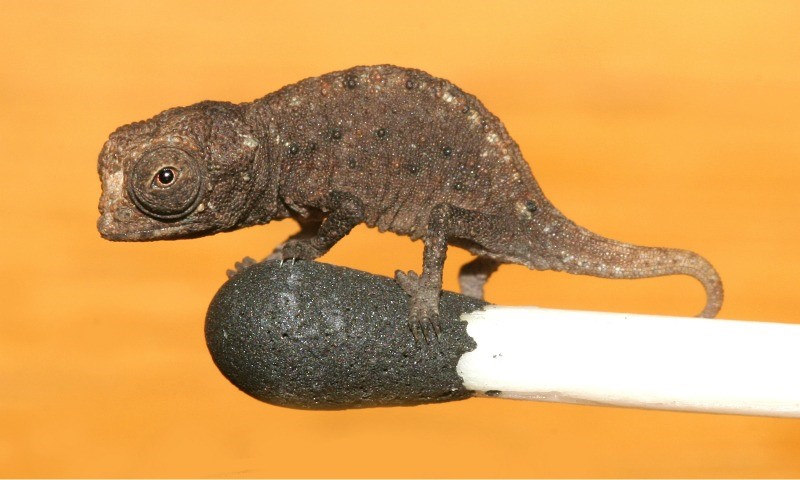 © Wikimedia.org/Frank Glaw, Jörn Köhler, Ted M. Townsend, Miguel Vences, CC BY
© Wikimedia.org/Frank Glaw, Jörn Köhler, Ted M. Townsend, Miguel Vences, CC BY
the brown water snake (Nerodia taxispilota) is a large species of nonvenomous natricine snake endemic to the southeastern United States. This snake is often one of the most abundant species of snakes found in rivers and streams of the southeastern United States, yet many aspects of its natural history is poorly known. Due to abundance and distribution throughout its biological range, this species could be used to investigate anthropogenic impacts on aquatic ecosystems by studying their movements. The brown water snake is very heavy-bodied, and its neck is distinctly narrower than its head. Dorsally, it is brown or rusty brown with a row of about 25 black or dark brown, square blotches down its back. Smaller similar blotches alternate on the sides. Ventrally, it is yellow, heavily marked with black or dark brown. Dorsal scales are in 27-33 rows (more than any other North American water snake), and it has two to four anterior temporals (usually one in others). Adults measure 30–60 in. (76–152 cm) in total length; record 69 in. (175 cm). (Source: Wikipedia.org, CC BY-SA)
The bullsnake (Pituophis catenifer sayi) is a large, nonvenomous, colubrid snake. It is a subspecies of the gopher snake (Pituophis catenifer). The bullsnake is one of the largest/longest snakes of North America and the United States, reaching lengths up to 8 ft. Adult bullsnakes average about 4 to 6 ft (1.2 to 1.8 m) in length, and specimens of up to 8 ft 4 in (2.5 m) have been recorded. Possibly being the largest subspecies of gopher snake on average, mature specimens can have an average weight in the range of 1–1.5 kg (2.2–3.3 lb), though the heavier known specimens can attain 3.6–4.5 kg (7.9–9.9 lb), with larger specimens being quite bulky for a colubrid snake. This makes bullsnakes among the largest snakes native to Canada and the United States, although they are generally not as long as indigo snakes nor as heavy or as large in diameter as rattlesnakes. They are usually yellow, with brown, white, black, or sometimes reddish blotching. The blotching pattern is large blotches on top, three sets of spots on the sides, and bands of black on the tail. Many color variations have been found, including albinos and white varieties. A scale count is required to distinguish juvenile bullsnakes from other juvenile gopher snakes. (Source: Wikipedia.org, CC BY-SA)
The Burmese python (Python bivittatus) is one of the largest species of snakes. It is native to a large area of Southeast Asia and is listed as Vulnerable on the IUCN Red List. Until 2009, it was considered a subspecies of the Indian python, but is now recognized as a distinct species. It is an invasive species in Florida as a result of the pet trade. The Burmese python is a dark-colored non-venomous snake with many brown blotches bordered by black down the back. In the wild, Burmese pythons typically grow to 5 m (16 ft), while specimens of more than 7 m (23 ft) are unconfirmed. This species is sexually dimorphic in size; females average only slightly longer, but are considerably heavier and bulkier than the males. In general, individuals over 5 m (16 ft) are rare. The record for maximum length of Burmese pythons is held by a female that lived at Serpent Safari for 27 years. (Source: Wikipedia.org, CC BY-SA)
Atheris is a genus of vipers known as bush vipers. They are found only in tropical subsaharan Africa (excluding southern Africa) and many species have isolated and fragmented distributions due to their confinement to rain forests. Like all other vipers, they are venomous. In an example of convergent evolution, they show many similarities to the arboreal pit vipers of Asia and South America. Seventeen species are currently recognized. They are relatively small in size, with adults ranging in total length (body + tail) from 55 cm (22 in) for A. katangensis to a maximum of 78 cm (31 in) for A. squamigera. The body is slender, tapering, and slightly compressed. The dorsal scales are overlapping, strongly keeled and have apical pits. Laterally these are smaller than the middorsals. Midbody there are 14–36 rows of dorsal scales. There are 133–175 rounded ventral scales. The subcaudal scales are single and number 38–67. The tail is strongly prehensile and can support the body while suspended from a branch or a twig. (Source: Wikipedia.org, CC BY-SA)
Lachesis, also known as bushmasters, is a genus of venomous pit vipers found in forested areas of Central and South America. The generic name refers to one of the Three Fates, Lachesis, in Greek mythology who determined the length of the thread of life. Four species are currently recognized. Adults vary in length from 2 to 3 m (6.6 to 9.8 ft), although some may grow to as much as 4 m (13 ft), making it the longest venomous snake in the Western Hemisphere. Bushmasters are the longest type of viper in the world. L. muta is possibly the largest of the three species currently recognized, although more scant information suggest L. stenophrys broadly overlaps in size and may average at a similar size, while L. melanocephala and L. acrochorda are seemingly slightly smaller than the prior two species. Although they are not the heaviest vipers, being surpassed in mass by the Gaboon viper and the Eastern diamondback rattlesnake, large adults still can weigh up to 3 to 7 kg (6.6 to 15.4 lb). Bushmasters are sexually dimorphic in size, with males reaching larger sizes than females. The bushmaster's tail ends with a horny spine which sometimes vibrates when disturbed like rattlesnakes. This has led to some calling it 'the mute rattlesnake'. (Source: Wikipedia.org, CC BY-SA)
 © Wikimedia.org/Christopher Murray, CC0
© Wikimedia.org/Christopher Murray, CC0
A caiman (also cayman as a variant spelling) is an alligatorid belonging to the subfamily Caimaninae, one of two primary lineages within the Alligatoridae family, the other being alligators. Caimans inhabit Mexico, Central and South America from marshes and swamps to mangrove rivers and lakes. They have scaly skin and live a fairly nocturnal existence. They are relatively small-sized crocodilians with an average maximum weight of 6 to 40 kg (13 to 88 lb) depending on species, with the exception of the black caiman (Melanosuchus niger), which can grow more than 4 m (13 ft) in length and weigh in excess of 1,000 kg (2,200 Ib). The black caiman is the largest caiman species in the world and is found in the slow-moving rivers and lakes that surround the Amazon basin. The smallest species is the Cuvier's dwarf caiman (Paleosuchus palpebrosus), which grows to 1.2 to 1.5 m (3.9 to 4.9 ft) long. There are six different species of caiman found throughout the watery jungle habitats of Central and Southern America. The average length for most of the other caiman species is about 2 to 2.5 m (6.6 to 8.2 ft) long. Caimans are distinguished from alligators, their closest relatives, by a few defining features: a lack of a bony septum between the nostrils, ventral armor composed of overlapping bony scutes formed from two parts united by a suture, and longer and sharper teeth than alligators, plus caimans tend to be more agile and crocodile-like in their movements. The calcium rivets on caiman scales make their hides stiffer and thus less valuable than those of alligators and crocodiles, both of which have a similar appearance, but are more pliable. (Source: Wikipedia.org, CC BY-SA)
The genus Dracaena (romanized form of the Ancient Greek δράκαινα - drakaina, 'female dragon'), also called caiman lizards or water tegus, is in the teiid family, along with tegus and ameivas. Caiman lizards are found in South America in Ecuador, Colombia, Paraguay, Peru and Brazil. These semiaquatic lizards spend a lot of time in the water and inhabit marshes, streams and flooded forests. Caiman lizards often bask on branches overhanging the water. The caiman lizards are built similarly to their cousins the tegus, with a large, heavyset body and short but powerful limbs. Their heads are bulky and often a red or orange color. Their jaws are heavily muscular to help aid in eating its normal prey of snails, crawfish and fresh water clams. They also have a few adaptations that help them in their watery habitat. They have long, laterally flattened tails, similar to their namesake, the yacare caiman. The long tails help the caiman lizards to successfully swim and dive. They also have clear third eyelids which are thought to act like a pair of goggles underwater. (Source: Wikipedia.org, CC BY-SA)
Morelia spilota, commonly referred to as the carpet python, is a large snake of the family Pythonidae found in Australia, New Guinea (Indonesia and Papua New Guinea), Bismarck Archipelago, and the northern Solomon Islands. Many subspecies are described; ITIS lists six, the Reptile Database six, and the IUCN eight. M. spilota is a large species of python in the genus, reaching between 2 and 4 m (6.6 and 13.1 ft) in length and weighing up to 15 kg (33 lb). M. s. mcdowelli is the largest subspecies, regularly attaining lengths of 2.7–3.0 m (8.9–9.8 ft). M. s. variegata is the smallest subspecies, typically 120–180 cm (3.9–5.9 ft) in length. The average adult length is roughly 2 m (6.6 ft). However, one 3-year-old captive male M. s. mcdowelli, measured in Ireland, was found to exceed 396 cm (12.99 ft). Males are typically smaller than females; in some regions, females are up to four times heavier. The head is triangular with a conspicuous row of thermoreceptive labial pits. The colouring of M. spilota is highly variable, ranging from olive to black with white or cream and gold markings. The patterning may be roughly diamond-shaped or have intricate markings made up of light and dark bands on a background of gray or a version of brown. (Source: Wikipedia.org, CC BY-SA)
Echis (common names: saw-scaled vipers, carpet vipers) is a genus of vipers found in the dry regions of Africa, the Middle East, India, Sri Lanka and Pakistan. They have a characteristic threat display, rubbing sections of their body together to produce a 'sizzling' warning sound. The name Echis is the Latin transliteration of the Greek word for 'viper' (ἔχις). Like all vipers, they are venomous. Their common name is 'saw-scaled vipers' and they include some of the species responsible for causing the most snakebite cases and deaths in the world. Twelve species are currently recognized. Saw-scaled vipers are relatively small snakes, the largest species (E. leucogaster, E. pyramidum) usually below 90 cm (35 in) long, and the smallest (E. hughesi, E. jogeri) being around 30 cm (12 in). The head is relatively small and is short, wide, pear-shaped and distinct from the neck. The snout is short and rounded, while the eyes are relatively large and the body is moderately slender and cylindrical. The dorsal scales are mostly keeled. However, the scales on the lower flanks stick out at a distinct 45° angle and have a central ridge, or keel, that is serrated (hence the common name). The tail is short and the subcaudals are single. A saw-scaled viper of the genus Echis may be responsible for biblical claims of a fiery flying serpent. (Source: Wikipedia.org, CC BY-SA)
Crotalus durissus, known as the South American rattlesnake, tropical rattlesnake, and by other names, is a highly venomous pit viper species found in South America. It is the most widely distributed member of its genus. Currently, seven subspecies are recognized. A large Neotropical rattlesnake, it grows to a length of 1.5 m (4.9 ft), and rarely to a maximum length of 1.9 m (6.2 ft). It has two distinct stripes starting at the base of the head. Within the lines, the color is lighter than the stripes. The color and pattern of the body are quite variable, most with an 18–32 dorsal with a darker diamond, and rhombic spots, 25–33 (usually 27) rows of dorsal scale in the middle of the body. The head has a dark brown bar at the top, with a dark post-orbital band. The color of the belly varies, it can be white or yellowish, with light gray spots, becoming darker towards the tail. The tail is usually gray, with dark and vague crossed bands. (Source: Wikipedia.org, CC BY-SA)
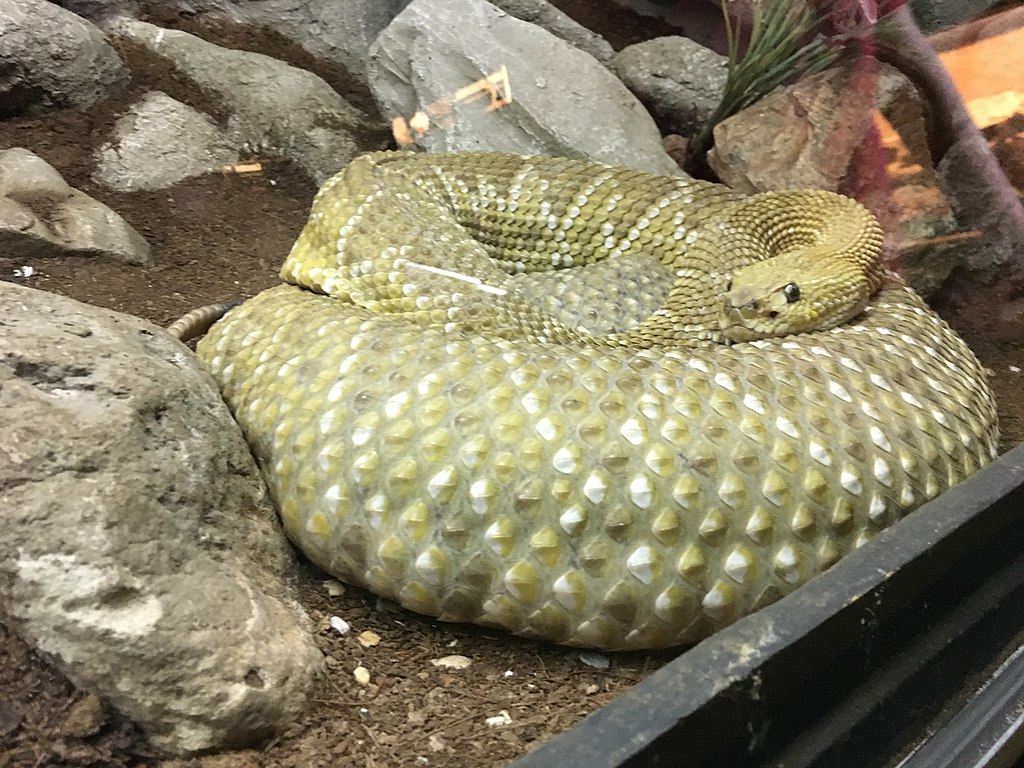 © Wikimedia.org/Rivera0997, CC BY-SA
© Wikimedia.org/Rivera0997, CC BY-SA

Time for recess! Post a comment, ask a question or write a review. Feel free to let us know what you think!
Ben fransada turkce deralere girecem ehliyet ici sinavlari bilen bana yardimci olur mu
Mrhaba bu hafta yaziliya girecem bana yardimci olmak isteyen varmi isvec yazilisina cok korkuyorum yalniz
Orda tabela var otoban başlangıçı icin sorular bunlar Otoyolun başlangıçı Park etmek yasaktır Otobanın başlangıcı Giriş yapmak yasaktır Ben otobanın başlangıçı basıyom yok yanlışmiş otoyolun başlangıçıymız tabi biz türkiyede yaşıyoz unutum ben amk
Elinize sağlık Türkiye'de olmayan birçok levha var.Mantık yürüterek dogru cevapları bulmaya çalıştım.
Gercekten emeginize saglık. Alakasız ve yanlıs birsürü testle karşılaştım, sonunda faydalı bir sayfaya denk geldim.
Merhaba benim Türk ehliyetim var Romanya ehliyeti ile değiştirmek istiyorum nasıl yapabilirim
Dun sinava girdim tek bir soruyla kaybettim dogru bildim konturol ettim 3 soruyu yannis ciklarla cevirdim
HAZIRLAYANLARDAN ALLAH RAZI OLSUN IN$LLH COK GÜZEL-TEK SIKINTI COK AZ TÜRKCE CEVIRIMLERDE AMA OLSUN BEN COK BEGENDIM TE$EKKÜRLER
Bazı sorularda yazımı da aynı olan 2 aynı doğru cevap var. Örnek: Yayalar için yolun sonu. Yerleşim alanının sonu. Bir yerleşim alanının başlangıcı. Yerleşim alanının sonu.